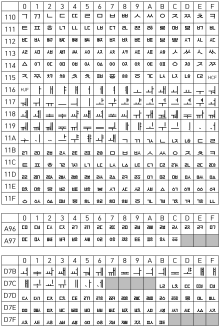This article may overuse or misuse colour, making it hard to understand for colour-blind users.(July 2024) |
This is the list of Hangul jamo (Korean alphabet letters which represent consonants and vowels in Korean) including obsolete ones. This list contains Unicode code points.
Contents



In the lists below,
- code points in orange were added in Unicode 5.2. [1] These should form a syllabic square when conjoined with other jamo characters, but unupdated fonts, browsers or systems may not be able to do so.
- code points in pale violet red were corrected in Unicode 5.1 and the South Korean national standard KS X 1026-1 (unofficial English translation).
- code points highlighted with yellow background are part of the modern Hangul subset which are arithmetically composable (in pairs or triples of jamo characters) to canonically equivalent precomposed Hangul syllables in
U+AC00–U+D7AF(see below for further explanation):U+1100–U+1112: 19 modern Hangul leading consonant jamosU+1161–U+1175: 21 modern Hangul vowel jamosU+11A8–U+11C2: 27 modern Hangul trailing consonant jamos- all other jamos (shown in the tables below without the highlighting background) are obsolete; they are not used in modern Korean (some Korean input methods or keyboard layout may not allow entering them).
- "Hanyang Private Use" is a character code system that was used in Hangul word processor version Wordian to 2007. This system maps old Hangul to the Private Use Area in Unicode. In Hangul Office 2010 and its subsequent versions, Hanyang PUA system was deprecated and replaced with the standard Unicode Hangul jamo encoding.
The Hangul compatibility jamo characters (U+3130–U+318F) are encoded in Unicode for compatibility with the earlier South Korean national standard KS X 1001 (formerly KS C 5601). Compatibility and halfwidth (U+FFA0–U+FFDC) characters are not composable into syllabic squares (because of the ambiguity for delimiting syllables when using them), but they may be used in legacy applications which cannot support or render the full Hangul syllable set such as low-cost terminals or old printers: these compatibility characters may exist either in fullwidth variant, or in halfwidth variants (mostly used in terminals with low resolution).
Unicode also defines a large subset of precomposed Hangul syllables (U+AC00–U+D7AF) made of two or three jamo characters for use in modern Korean (their canonical decomposition mappings are not found in the UCD, but are specified with an arithmetic algorithm only in The Unicode Standard, Chapter 3 Conformance) and are decomposable into equivalent sequences of two jamo characters (one in each of the first two subranges above) or three jamo characters (one in each of the three subranges above). Their initial encoding in Unicode 1.0 was different (and not compatible with later versions of Unicode) and were based on the compatibility jamo characters (ignoring the distinction between leading and trailing consonants, making the automatic composition of Hangul square sometimes ambiguous or wrong).

